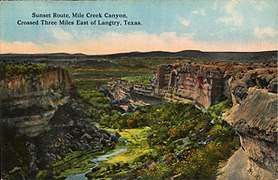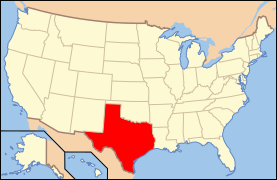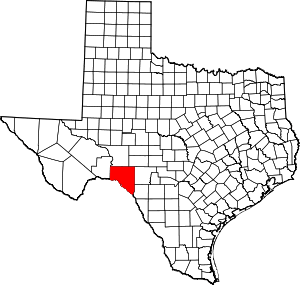Mile Canyon
Mile Canyon or more recently known as Eagle Nest Canyon is a tributary canyon of the Rio Grande entering on the north side of the river just downstream from Langtry, Texas. Mile Canyon received its name due to its length being approximately one mile long. In more recent years, this canyon is more commonly referred to as Eagle Nest Canyon, named after a nesting pair of golden eagles observed nearby.[3] It has been an important area of many archaeological and geological expeditions over the past century.
Mile Canyon | |
 Postcard depiction, 1908 | |
| Location | Address restricted[1] |
|---|---|
| Nearest city | Langtry, Texas |
| Area | 150 acres (61 ha) |
| NRHP reference No. | 70000773[2] |
| Added to NRHP | October 15, 1970 |
Environmental setting
Mile Canyon is found on the northern boundary of the Chihuahuan Desert.
Geomorphology
Archaeology
This canyon and its surrounding upland edge contains numerous sites ranging from dry rockshelters to burned rock middens to upland “hearth” fields.[4] The canyon is primarily recognized for Bonfire Shelter, Kelly Cave, Eagle Cave, and other natural shelters that were used by Native Americans up to 13,500 years ago. Bonfire Shelter features a prehistoric bison jump, where wild herds of bison were driven off the cliff edge by Native American hunters and died below. The bison were then harvested for clothing, food and tools. The jumps occurred as early as 9700 BC and as recently as 800 BC.[5]
The canyon was added to the National Register of Historic Places in 1970 AD. The historic district comprises a 1,500 acre (6 km2) area entirely on private land.
Currently (2014), archaeological research is being conducted on the many sites found within and around the canyon by a crew from Texas State University. This research is part of a multiyear research design focused on the Lower Pecos Canyonlands called the Ancient Southwest Texas Project.
References
- Federal and state laws and practices restrict general public access to information regarding the specific location of this resource. In some cases, this is to protect archeological sites from vandalism, while in other cases it is restricted at the request of the owner. See: Knoerl, John; Miller, Diane; Shrimpton, Rebecca H. (1990), Guidelines for Restricting Information about Historic and Prehistoric Resources, National Register Bulletin, National Park Service, U.S. Department of the Interior, OCLC 20706997.
- "National Register Information System". National Register of Historic Places. National Park Service. July 9, 2010.
- "Eagle's Nest". Historical Marker Database. Retrieved 3 July 2014.
- "Ancient Southwest Texas Project". Retrieved 3 July 2014.
- Texas Beyond History: Bonfire Shelter
External links
"Eagle's Nest - Langtry ~ Marker Number: 13175". Texas Historic Sites Atlas. Texas Historical Commission. 2003.


